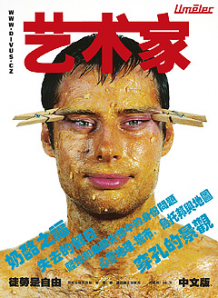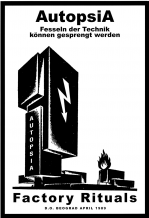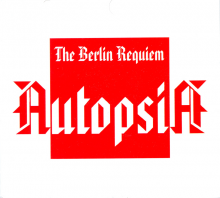| Zeitschrift Umělec 2003/1 >> Bowl | Übersicht aller Ausgaben | ||||||||||||
|
|||||||||||||
BowlZeitschrift Umělec 2003/101.01.2003 Tomáš Vaněk | theme | en cs |
|||||||||||||
|
Finding the right thought is not easy. Artist Tomáš Vaněk talked several times with artist Jan Turner and tried to discover what was crucial. They ended up corresponding with each other for two weeks. Vaněk would send to Turner a convolute of questions and he then aswered. Sanding the bowl...
Tell me something about the time you were collecting pinecones in the forest. I was collecting pinecones in the forest and collecting just the right ones. Distinguishing between them was a real pleasure. Maybe not so much the distinguishing itself, but rather the huge number of reasons for and sometimes even against. Rarely does something so universally understandable happen. The sun, breeze, flies, blackberries, branches all helped in making the choice. The forest is my friend. Is it necessary for you to have your things, objects exhibited in galleries? I don’t think it’s completely necessary, but I actually somewhat count on galleries. They are usually so rigidly cut out from the usual space. The people that meet there are also somewhat cut out and expect that something’s going to happen there. That’s an advantage. And if you have in mind the gallery as a space, then I do need it. I need a dry, calm, clean, white, non-complicated space. Will you tell me where you get your ideas? I constantly put my usual activities into themes. Themes, like excretion for example, emerge if I am on a trip, so then excretion in a landscape. Petty crimes, when I see something nice somewhere. And maybe also disappearance, exchange. When I am forced to take care of my body because it’s breaking down, then the medic with an injury is created. When a loved one dies, this necessitates that I immediately make relative everything around it, and I try to imitate it so that things are, and at the same time, disappear. What do you mean, so that things are and at the same time disappear? I imagine that when the function of the object is somehow diluted, then the object partially disappears. It’s a kind of donkey bridge to a real disappearance. 5. Do your ideas hit you like viruses, or do you have to coax them? Up till now I thought that ideas were viruses. The idea has always co-existed along with some kind of configuration, copying its genetic structure, re-coding it, so that the whole thing changes. But if you have in mind how I anticipate it, I would say that I fertilize the soil for homeopathic ideas. It is a rare form of coaxing. Tell me something about the hat-stand? The most important thing about this sculpture was the hat it wore. There is the encoded joy in it, of skiing, puberty, heat 15 years old. Old dandruff. It has a rich memory. And you can see it. I don’t want to say that this is the only thing that makes the whole sculpture understandable. All the same, I consider the memory to implicitly contain the possibility of sharing and understanding. Without a specific content, of course. On the level of waves. When I look at your things I have the feeling that they come, more than anything else, from the first impulse, a sparkling flash. The impulse is the gateway to a chain of associations, and this only signals a larger intensity of being, and it lasts maybe 15 minutes. For example, I find aluminum strips and maybe wood planks and at that moment it begins to be clear that it is necessary to try and see if I can wrap them around each other. This makes a kind of braid, in principle not entirely dissimilar to how they braid fancy Christmas bread. Then of course comes in the mezzo-impulse. Basically this is about how it’s still necessary to do something with this fancy bread. I bend it up, set it up on legs and now it’s a table. Sometimes this ends the phase of impulses and begins the phase of reflection. Out of this process comes the fact that the table is a redefined fancy bread, and implicitly one discovers here a hierarchy of order. That the table in natural selection outweighed the fancy bread. It seems that something in the form of the fancy bread doesn’t integrate the essential characteristics to the extent that, at a given moment, it could grant a sufficiently solid and playful form to the object. As a whole, it could be said that the fancy bread doesn’t integrate as many principles as the table. And somehow the table is more substantial than the fancy bread. This piece of knowledge is extremely important, even if I don’t manage to find a context for it and it isn’t almost useless to me. Maybe it occurs to me to use it in a crossword puzzle: something more substantial than fancy bread, it has four legs and you can put a plate on it — five spaces. But going back, I also see that the table at the same time integrates some of the characteristics of the fancy bread. It is specific food made exclusively for Christmas. It has all the characteristics of a holiday food — sugary, fatty, floury, eggy, full of almonds and raisons. I want to say that it is not a universal food that integrates the complete gamut of vitamins, protein, minerals and trace elements and to constantly consume only fancy bread is an accumulative diet of the missing. Just as fancy bread is not a universal food, you could also say that the table cannot carry everything on earth. A standard table, for example, cannot carry an excavator. And now we come to the important moment. During the association process that began with the fancy bread and ended with the table, it has been revealed that the dominant characteristics of both the bread and the table have potential. What I am getting at is that as long as the table I am making doesn’t resemble the average table, it’s not about a type of willful reduction, but the result of causality, which the spices somewhere in the subconscious and in everyday life are ground by the turbulence of pragmatic functionalism, so at first glance it’s not noticeable. Personally I am an advocate of far stricter tie of the object to its meaning. I would like to say that the fact that the table cannot carry 300 kilos, but only 40 dkg, and it can handle only longish objects which are not sphereical, is basically only an imperceptible change of dynamics inside the system of the relationship of the objects and their function. Can you imagine other variations of objects on the table — a table that could be made for the theme of change of the dynamics inside the system of the relationships of objects and their function? Is the exploration into variations somehow important to you? Frankly speaking, I wouldn’t expect anything from it. The theme by itself of a change of dynamics through repetition is played out. Between the two extremes I would come to a method of thought that I consider slightly vulgar. The first time is the best. I vary things, but in other objects. A variation on the table is perhaps the chamber-pot or hat-rack. Or even the floor. I am talking about your things with someone, I often find myself during the description using the word brutal. Do you think that your things are brutal? I guess they’re brutal because they have their own utilitarianness, close to the sectarian way of thinking. You see, there’s always only one possibility of how to do it, one constellation, one attempt, only once, the first time and it has to keep flowing. Relaxing the speed is also important. Why it’s like that, I don’t know. My father was fast and mother brutal. Maybe it has its roots there. Concepts that accentuate plurality and democracy in their possibilities after all slide into one vagueness, and this doesn’t speak to me at all. Anyway in the brutality with which these things radiate, there is an encoded kindness, which according to me, God knows why, should be brisk and fast and in its own way brutal. What did you mean by the sectarian way of thinking? Dogma in the background. Yes or no in the result. Both extremes are squarely represented. At the same I think that the objects do quite clearly say yes or no, which does sound Taoist, but the intensity is Jehovah-Moonist. When I saw your objects after a long time, they reminded me that they have some kind of dada energy about them, containing the desire for swerving away or maybe disjointing. I think that dada is art of the impossible in the simplest forms that it offers. In the nonsense that exposes the multifarious gamut of connections. And at the same time in many respects it is disjointed. I have the impression that this disjointing always imitates events from childhood. The pinecones that you collected, you put in a bag with a print of a stag on it and you exhibited it. I had the feeling that the pleasure of collecting obscured, hid, and in the end was about the object that came before the story, but it seemed to me that it was sent away. Yes, the pleasure disappeared, another story covered it up. I attempted to see if at first glance in the invisible process there accrues some kind of energy in the result. I found out for myself that it’s true. A good and strong experience is universally conveyed even when it is masked. Pleasure from the collecting and choosing of pinecones, but I still definitely use far more in the first plan. You make objects, you paint, you make music. Which of these is your main form and what additional disciplines do you have? All of them are main and at the same time subordinate, they compliment each other. In August I usually feel the need to play. January and February means painting. Spring belongs unambiguously to objects, in June and July my biggest pleasure is to write. This is one category of activity that serves to ventilate. Other activities serve better for absorption. For example, I absorb Tai-chi. It is unbelievable all that gets relaxed when the body relaxes. I also try various therapies on myself. Chinese acupuncture, homeopathy, psycho-kineziology, family constellations. They’re all great. These disciplines map the connections that I always wished existed in the world. From these ventilating disciplines one discovers many thing. I have one more masochistic project. I act in the theater. Actually, to be exact, one play in maybe three years. It is a kind of Švejk-like play about railway workers and I have several replicas. Theater of his kind I sincerely don’t understand at all, and I don’t think I would voluntarily go to this play. The interesting thing is that this kind of play in recent years has literally experienced a huge boom. There have recently been at least five under production, they play them in professional theater. They speak about it in the superlative and certainly someone who is not completely meaningless has dubbed it the play of the year. Once [amateur theater festival] Jiráskův Hronov won. I don’t understand it at all, and this is very exciting. Therefore I am going to continue following the path of the actor. Is there a story behind the bowl in the bowl [the work in which one bowl floats inside another bowl]? There is. It’s a Zen matter. The similarity of the large and the small. Water. Peace. It’s called chamber-pot for our grimy world. Ex-cretion is often a resemblance of the bigger to the smaller far more than we would wish. Your floor really made an impression on me, so simple and banal, the bungy cords and sheet metal. Do you want to say something about it? I’m glad when the floor makes such an impression on someone. Using the bungy cords I tried to accentuate the pressure and sometimes even the pre-pressure, which always happens on the floor during its service. I wanted to put its humble service on show, show it to people. It also occurred to me that your objects are reduced to being some kind of signage, for example fence = grating, home = sign for home etc. Are your works supposed to be specific activated signs? I would begin with the fact that the sign for me is not a starting point. I don’t work so that, in the sense of the ready-made, I discover somewhere a sign that then I deform-activate a rearranged context of meanings. So the sign is not a starting point, but it stands somewhere far beyond the original impulse for something to manipulate. I understand it as a certain agreement with which I model again, as from zero with lost memory and where the only guide serves the collective subconscious. I imagine in this way the whole contextual intertwining of the ties is created again. Here I come to the many kinds of ties the sculpture can present. The important thing is that my own self does not participate in this process, which runs more or less parallel with my ideas, as long as I have any at the given moment, they don’t participate. It a freeing feeling. Your personal mini-catalogue has the title Social Swoons. Please explain how you came up with this? While looking back at the series of objects we have been talking about here, I noticed that they have defects in the area of usefulness. So social because the results of the defects are localized especially in the social sphere, where the flash of the function of the objects is heading. The swoons are only paraphrases for the insufficiency of sufficient social consciousness, resulting in the mentioned defects. With this catalogue I would like to positively define the area of insufficiency.
01.01.2003
Empfohlene Artikel
|
|||||||||||||
|
04.02.2020 10:17
Letošní 50. ročník Art Basel přilákal celkem 93 000 návštěvníků a sběratelů z 80 zemí světa. 290 prémiových galerií představilo umělecká díla od počátku 20. století až po současnost. Hlavní sektor přehlídky, tradičně v prvním patře výstavního prostoru, představil 232 předních galerií z celého světa nabízející umění nejvyšší kvality. Veletrh ukázal vzestupný trend prodeje prostřednictvím galerií jak soukromým sbírkám, tak i institucím. Kromě hlavního veletrhu stály za návštěvu i ty přidružené: Volta, Liste a Photo Basel, k tomu doprovodné programy a výstavy v místních institucích, které kvalitou daleko přesahují hranice města tj. Kunsthalle Basel, Kunstmuseum, Tinguely muzeum nebo Fondation Beyeler.
|




































 We Are Rising National Gallery For You! Go to Kyjov by Krásná Lípa no.37.
We Are Rising National Gallery For You! Go to Kyjov by Krásná Lípa no.37.
Kommentar
Der Artikel ist bisher nicht kommentiert wordenNeuen Kommentar einfügen